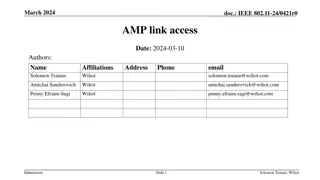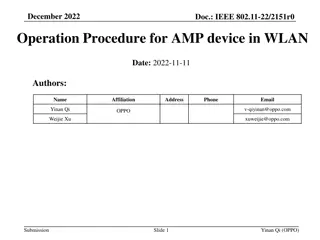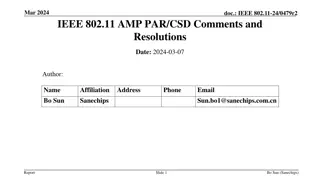
Improving Nursing Education Experience for Male Students and CRNAs
This study explores gender barriers faced by male student registered nurse anesthetists and CRNAs and emphasizes the importance of representation and effective communication in nursing education. The research aims to mitigate historical gender barriers to ensure a robust and equitable nursing workforce. Survey results highlight differences in representation and communication as key barriers to learning in nursing programs, particularly in obstetrical nursing. Male SRNAs and CRNAs in Illinois face challenges related to mentorship opportunities and communication in their educational journeys.
Download Presentation

Please find below an Image/Link to download the presentation.
The content on the website is provided AS IS for your information and personal use only. It may not be sold, licensed, or shared on other websites without obtaining consent from the author. If you encounter any issues during the download, it is possible that the publisher has removed the file from their server.
You are allowed to download the files provided on this website for personal or commercial use, subject to the condition that they are used lawfully. All files are the property of their respective owners.
The content on the website is provided AS IS for your information and personal use only. It may not be sold, licensed, or shared on other websites without obtaining consent from the author.
E N D
Presentation Transcript
IMPROVED REPRESENTATION AND EFFECTIVE COMMUNICATION POSITIVELY IMPACT THE NURSING EDUCATION EXPERIENCE OF MALE STUDENT AND CERTIFIED REGISTERED NURSE ANESTHETISTS Max Bader RN NAT-3 John Gockman RN NAT-3 August 7, 2020
Summary: Aim Background/introduction Methods Results Conclusion Implications for nursing/health policy
The purpose of this study was to investigate past experiences with gender barriers among male student registered nurse anesthetists (SRNAs) and Certified Registered Nurse Anesthetists (CRNAs) in their educational and professional careers. AIM
Men have been underrepresented in the nursing profession in modern history. As the demand for nursing care increases globally, it is imperative that any gender barriers historically preventing men from pursuing nursing careers are acknowledged and mitigated to ensure a robust and equitable nursing workforce in the future. To date, no research has been conducted on the gender barriers faced by men in nurse anesthesia. BACKGROUND/INTRODUCTION
This descriptive, quantitative study used survey methodology. Student and Certified Registered Nurse Anesthetists who are members of the Illinois Association of Nurse Anesthetists (IANA) were recruited via email and voluntarily completed the web-based Inventory of Male Friendliness in Nursing Programs (IMFNP) 23-item survey. Data were analyzed using descriptive statistics. METHODS
Respondents reported representation and communication differences between men and women as the main gender-related barriers to their learning in nursing school. Obtaining adequate clinical experiences in obstetrical nursing was also a barrier to the learning of respondents. Most of the respondents were white with an average age of 47.83 years. 62.8% of the respondents were over 40 years old. RESULTS
Male SRNAs and CRNAs in the US state of Illinois experience gender barriers during their nursing education. The men surveyed identified lack of male representation in nursing, few opportunities to form mentorship relationships with male RNs/faculty and communication differences between men and women as contributing factors to perceived gender barriers. Greater attention to the needs of male nursing students could help men transition to the nursing role more easily and improve the representation of men in the field overall. CONCLUSION
Understanding historical and modern barriers to men entering nursing and the lived experiences of male SRNAs and CRNAs will help develop new policies and practices that support men as they pursue careers in nursing and nurse anesthesia. IMPLICATIONS FOR NURSING
Strategies/solutions to issues raised by this research: Formal education on effective communication skills in nursing curricula Rehearsing potentially awkward conversations with patients in class or clinical pre-huddles Introducing content in school about the history and contribution of men in nursing Online module with pre/post test Writing assignment that promotes inquiry and reflection on men in nursing Facilitation of male student-RN mentorship relationships IMPLICATIONS FOR NURSING
OLynn, C. E. (2004). Gender-based barriers for male students in nursing education programs: Prevalence and perceived importance. Journal of Nursing Education, 43(5), 229-236. Powers, K., Herron, E. K., Sheeler, C., & Sain, A. (2018). The Lived Experience of Being a Male Nursing Student: Implications for Student Retention and Success. Journal of Professional Nursing, 34(6), 475-482. American Association of Colleges of Nursing. (2019). Fact sheet: Nursing shortage. From http://www.aacn.nche.edu/Media/pdf//NursingShortage.htm SELECT REFERENCES






















